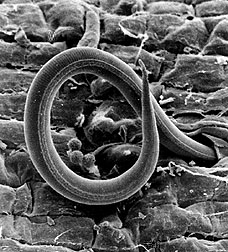Northern root-knot nematode lives underground and attacks plant roots.
Northern root-knot nematode (Meloidogyne hapla). Northern root-knot nematodes live under the ground and attack plant roots. Almost all vegetable and garden plants can be affected by the northern root-knot nematode, except cereals, grasses and bulbous plants. Not all plants are equally susceptible to this nematode; strawberries, beets, salsify, broad beans, onions and carrots, among others, are. Affected crops with a taproot, such as Belgian endive and carrots show growths.
After infection, small galls are formed on the plants roots in which the nematodes live. They feed on sap from the roots. Branching of the root system also occurs.
The northern root-knot nematode is less common in heavy clay soils; sandy and other light soils are preferred.
Where to find
- Strawberry
- Beetroot
- Black salsify
- Broad bean
- Onion
- Carrot
- Ornamental Plants (Forsythia)
Control
After infection, recovery is no longer possible.
Prevention
Keep the vegetable and ornamental garden weed-free; many weeds are host plants for the northern root-knot nematode.
Crop rotation with crops that are not susceptible to this nematode helps reduce the population of nematodes.

